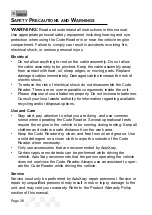
T
ECHNICAL
D
ESCRIPTION OF
OBD-I
AND
-II
(C
ONT
.)
Page 32
The Federal Clean Air Act Amendments of 1990 requires that all
vehicles sold in the United States meet OBD-II requirements by the
1996 model year. The first OBD-II systems appeared on selected
vehicle types in 1994.
Some important OBD-II requirements are: Vehicle service
information available to all technicians; Standardization of Terms:
Use of SAE J-1930 recommended terms; OBD-II requires a
common Diagnostic Link Connector (DLC) and specifies its location
in the vehicle; Generic scan tool; Generic emission related
Diagnostic Trouble Codes (DTC); and a very specific Malfunction
Indicator Light (MIL) illumination protocol.
One very important part of the OBD-II requirements is that
technical service information for emissions related components and
systems, which could affect the vehicle's emission levels, will be
available to all technicians; not just OEM dealership technicians.
This will allow all technicians to better understand how the systems
recognize faults and set the DTCs. The technician can now make a
repair and verify the repair by exactly duplicating the criteria that is
required for the DTC to be set.
Содержание EZ-READ
Страница 1: ...USERS MANUAL EZ READ REVISION 2 1...
Страница 36: ...Page 36 NOTES...
Страница 37: ...Page 37 NOTES...
Страница 64: ...Page 64...
















































